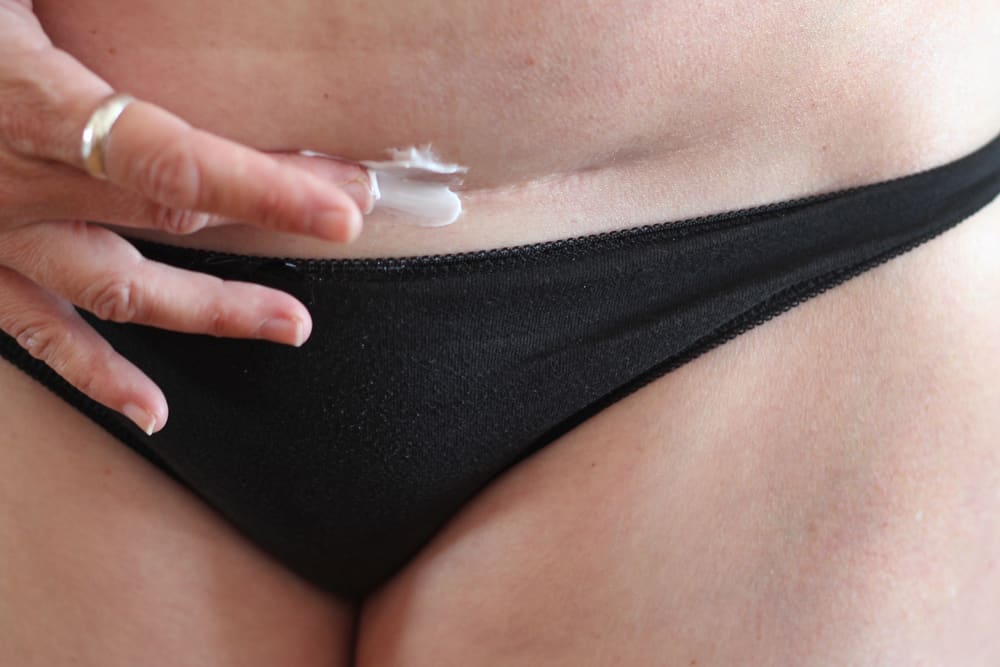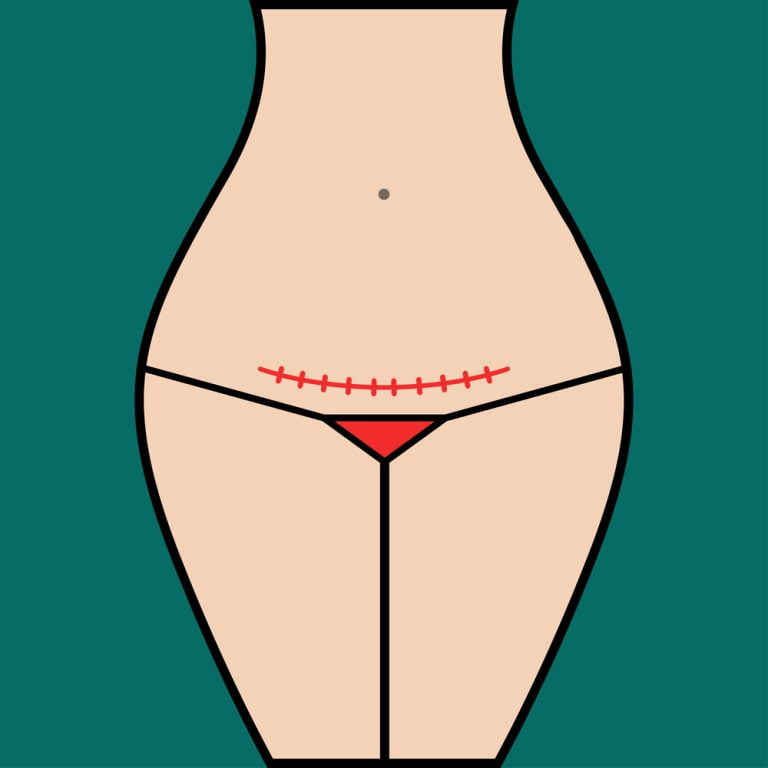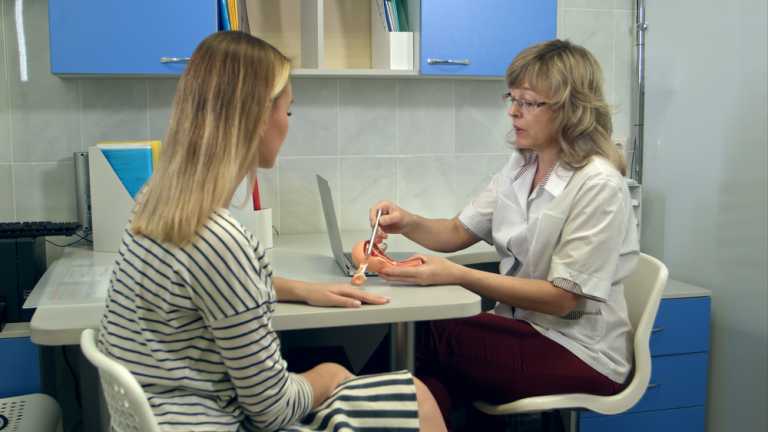C-section scars can itch like crazy, sometimes inside, sometimes on the surface. This is a massive problem if you’re still healing and banned from scratching. And, even if you’re years post-cesarean, there’s not exactly a subtle way to scratch it in public.
But don’t worry. If your c-section scar is itchy and you’re wondering, “What can I do?” the answer is a lot! We just need to figure out what’s causing it first.
Why Is Your C-Section Scar Itchy?
Your c-section scar could be itchy due to the following reason:
- Dry Skin
- Disrupted Nerve Endings
- Ingrown Hairs
- Adhesions
- Hypertrophic or Keloid Scars
Let’s discuss how to spot each problem and, most importantly, what to do about it.
Dry Skin Around Your C-Section Scar
Sometimes the itchiness can be caused by something as simple as dry skin. This is more likely if you’ve worked hard to clean your wound with soapy water.
How to Soothe Dry Skin Around a C-Section Scar
If your scar has healed, you can apply any of your favorite moisturizers, balms, or oils. Coconut oil and vitamin E oil are perfect remedies for itchy, dry skin.
For healing scars, it’s best to check with your doctor before applying anything. Some may be happy for you to use petroleum jelly or silicone scar creams. Others may prefer you to keep your wound dry.
If you’re allowed, silicone sheets or gels are a fantastic option. They don’t just seal in moisture to stop your itching; they also promote healing. This means they’ll take you from an angry purple, red, or dark scar to a silvery or more skin-toned line much faster.
Disrupted Nerve Endings
During your cesarean, nerve endings will have been severed and disrupted, which can cause oversensitivity.
Also, you can’t see it, but a lot is going on under that scar. As you heal, a new vascular network forms, nutrients, gases, and metabolites are exchanged, and collagen binds and sticks everything back together. Your nerve endings pick up on some of these sensations and translate them as itching.
How to Relieve Itching on a Healing C-Section Wound
Unfortunately, if your wound hasn’t healed yet, you can’t scratch it. You could cause infection or scratch numb areas too hard.
Don’t worry, though. You don’t have to put up with it. Cover your scar with a cold compress, wrapped in a clean cloth. This will help numb those nerve endings and give you some relief from the itch.
Ingrown Hairs on Your C-Section Scar
If a pesky regrowing pubic hair chooses to curl back on itself and grow into your skin, it’s ingrown. Unfortunately, this can happen around your scar, causing itchy red spots.
If you pick them or you get really unlucky, they can become infected. So, it’s important to learn how to deal with them.
How to Remove an Ingrown Hair From Your C-Section Scar
- Apply a Warm Compress – Clean the area with warm, soapy water. Then, hold a warm compress against the ingrown hair for 5 minutes. Repeat this twice a day for a week.
- Wipe Gently – Gently but firmly, wipe the spot with a clean washcloth and warm, soapy water. This could slowly pull out the hair loop, allowing it to grow freely.
- Wear Loose Fitting Clothing – Reduce the chance of infection by wearing breathable, natural materials.
- See a Nurse or Doctor – If you can’t find relief with these gentle methods, see your nurse or doctor. They may be able to free the hair using a sterile needle.
You mustn’t attempt to remove the hair with a needle, tweezers, or your nail. This could introduce bacteria and cause a nasty infection.
Your ingrown hair may be infected if it:
- Weeps pus
- Feels hot
- Is painful
- Becomes discolored.
In this case, visit your doctor. They may need to prescribe antibiotics.
Adhesions
Adhesions are bands of scar tissue that can form between the different layers of your belly as your incision heals. For example, they may join your skin to the muscle below it. This can cause pain, discomfort, and itchiness.
This is also why your scar might start itching years later, during another pregnancy, or if you gain or lose weight. As your body adjusts to its new shape, it will stretch or pull the adhesions, causing itching.
Luckily, you can break the bonds or prevent them from forming in the first place with a simple massage. You can start doing this on the area around your scar after 3 weeks. But, you should wait at least 6 weeks before massaging the scar itself.
How to Massage Your C-Section Scar
- Wash and dry your hands to prevent infection. You don’t need to use any oils or creams as you want friction to allow you to pull your skin.
- Lie down on a flat, comfortable surface with your legs outstretched.
- Place your fingers above your scar as if you are playing the piano. Move the skin up and down, left to right, and in circles. If you feel resistance in a particular area, keep working on it to stretch or free the adhesion.
- Sink your fingers into the muscle layer and repeat the movements.
- Bring your knees up to allow your fingers to sink deeper, to your organs. Repeat the movements.
When your c-section heals enough, you can do the same thing directly on your scar. Try to massage for 5 minutes every day until you no longer find any sticky bits. Then move to every week. And, finally, once a month.
Scar tissue will continue to form for 2 years, so keep up the monthly massage until that time has passed.
Hypertrophic or Keloid Scars
Hypertrophic scars are thick and stick out above your skin’s surface. Keloid scars are similar but can extend further than the original wound. If your scar is thick, red, raised, or lumpy, it’s likely to be a hypertrophic or keloid scar.
They form when your body overproduces collagen while healing.
How to Treat a Hypertrophic or Keloid Scar
Unfortunately, there are no effective methods to treat these scars yourself, and you’ll need to see a doctor.
They may advise:
- Corticosteroid injections – These may flatten and soften your scar and, most importantly, relieve the itch!
- Laser therapy – Lasers can be used in two ways. One option is to target the blood vessels. This stops the growth of the scar and reduces its redness. The other method uses a fractionated laser which makes microscopic holes in the scar tissue. This can help it stretch and soften.
- Surgery – If all other options have failed, you can have a surgical scar revision. This involves a surgeon either cutting out your original scar or making adjustments to it to reduce points of tension. However, there’s always a risk that the new scar will be hypertrophic or keloid.
What to Do if Your C-Section Scar Is Itchy and Smelly, Red, Burning, or Swollen
See a medical professional straight away if your c-section scar is:
- Red around the incision
- Swollen around the incision
- Smelly
- Leaking pus or other fluids
- Becoming more painful or feels like it’s burning
- Bleeding heavily
It could be a sign that your incision is infected.




